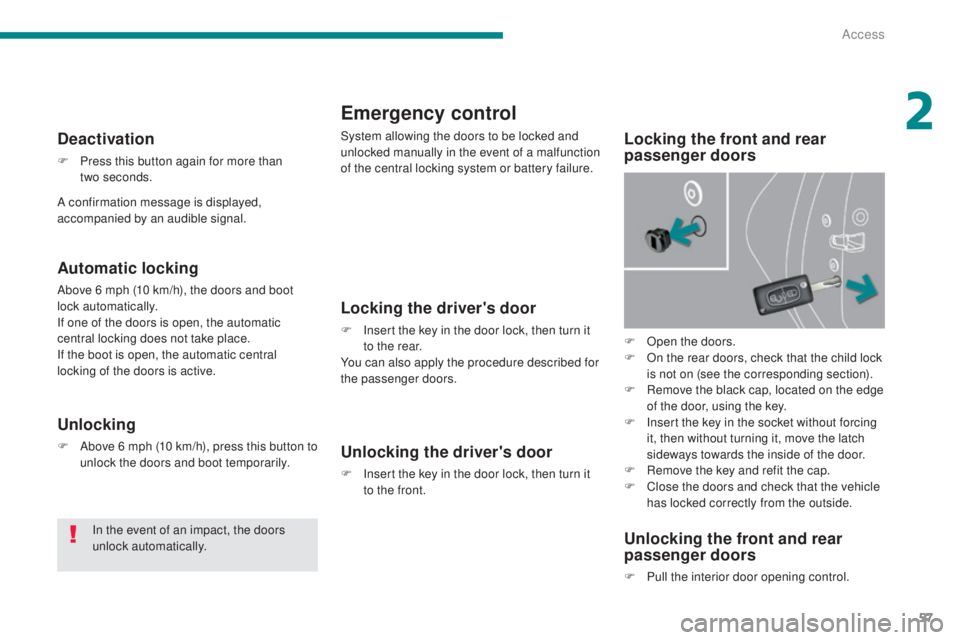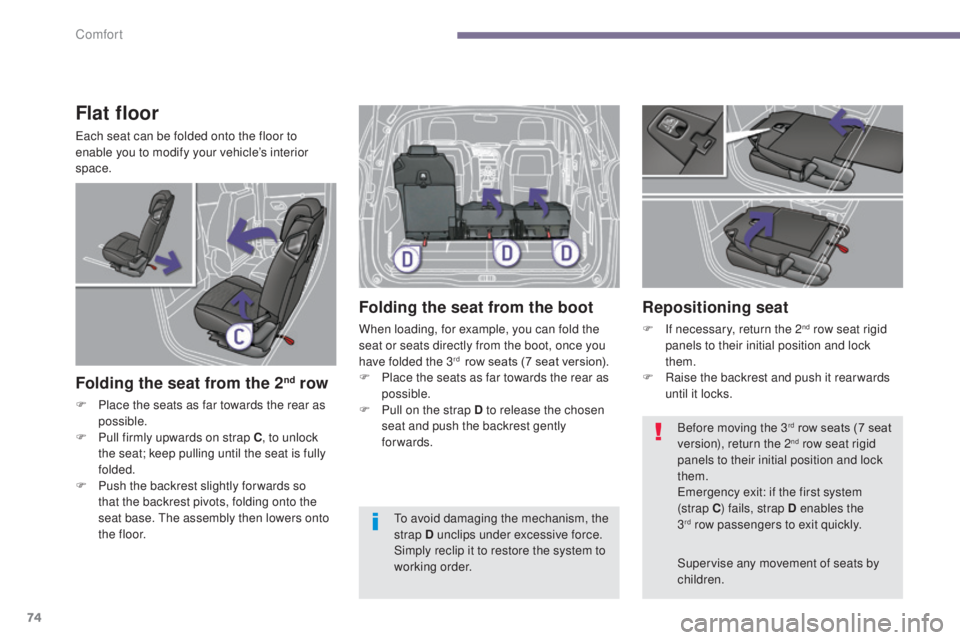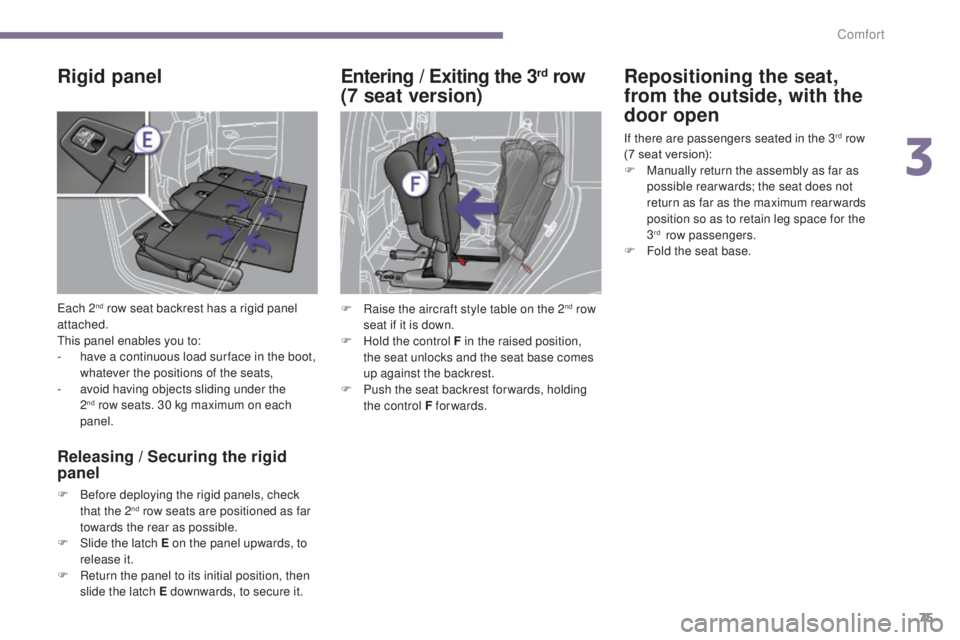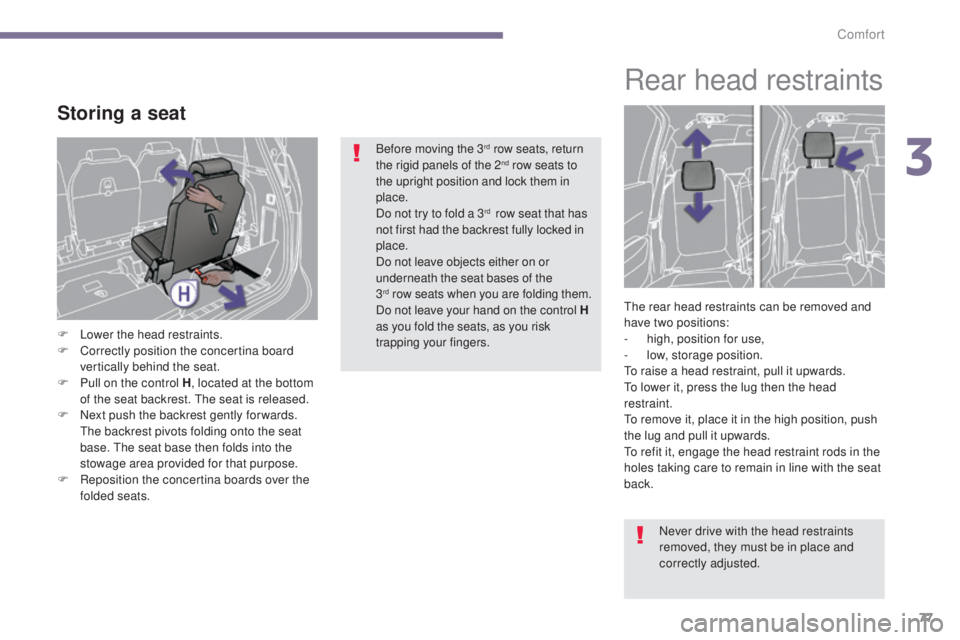Page 59 of 364

57
5008_en_Chap02_ouvertures_ed01-2015
Emergency control
System allowing the doors to be locked and
unlocked manually in the event of a malfunction
of the central locking system or battery failure.Locking the front and rear
passenger doors
Locking the driver's door
F Insert the key in the door lock, then turn it to the rear.
You can also apply the procedure described for
the passenger doors.
Unlocking the driver's door
F Insert the key in the door lock, then turn it to the front.
Unlocking the front and rear
passenger doors
F Pull the interior door opening control.
Automatic locking
Above 6 mph (10 km/h), the doors and boot
lock automatically.
If one of the doors is open, the automatic
central locking does not take place.
If the boot is open, the automatic central
locking of the doors is active.
Deactivation
F Press this button again for more than two seconds.
Unlocking
F Above 6 mph (10 km/h), press this button to unlock the doors and boot temporarily.
In the event of an impact, the doors
unlock automatically. F
O
pen the doors.
F
O
n the rear doors, check that the child lock
is not on (see the corresponding section).
F
R
emove the black cap, located on the edge
of the door, using the key.
F
I
nsert the key in the socket without forcing
it, then without turning it, move the latch
sideways towards the inside of the door.
F
R
emove the key and refit the cap.
F
C
lose the doors and check that the vehicle
has locked correctly from the outside.
A confirmation message is displayed,
accompanied by an audible signal.
2
Access
Page 60 of 364
58
5008_en_Chap02_ouvertures_ed01-2015
Boot
F After unlocking the vehicle, pull the handle and raise the tailgate.
-
w
hen the engine is running
and at speed of up to 6 mph
(10
km/h), this warning lamp
comes on, accompanied by a
message,
-
w
hen the speed of the vehicle
is above 6 mph (10 km/h), this
alert is accompanied by an
audible signal.
F
L ower the tailgate using the interior grab
handle.
When selective unlocking is activated,
the boot can also be opened by a
second press on the open padlock on
the remote control.
OpeningClosing
If the tailgate or one of the doors is not closed
correctly:
Access
Page 61 of 364
59
5008_en_Chap02_ouvertures_ed01-2015
Tailgate release
Unlocking
F Fold back the rear seats to gain access to the lock from inside the boot.
F
I
nsert a small screwdriver into hole A of the
lock to unlock the tailgate.
F
M
ove the latch to the left.
Locking after closing
If the fault persists after closing again, the boot
will remain locked.
System allowing the mechanical unlocking
of the boot in the event of a battery or central
locking system malfunction.
2
Access
Page 74 of 364
72
5008_en_Chap03_confort_ed01-2015
Table position, front passenger seat
This position, associated with that of the rear
seats, allows you to transport long objects
inside the vehicle.
The maximum weight on the seat is 30 kg.
Folding the seat backrest
F Raise the armrest and fold up the "aircraft" style table, fixed on the back of the seat.
F
C
heck that no object, either on or
underneath the seat, could hinder its
movement.
F
T
o make the operation easier, place the
head restraint in the low position (if the
seat is in the fully for ward position).
F
I
f your vehicle is fitted with the video pack,
place the protective cover on the head
restraint.
F
L
ift the control, located behind the seat,
then guide the seat back for wards.
Returning the seat to the normal
position
F Guide the seat backrest rear wards until it locks in place.
When the seat backrest is in this
position, only the 2
nd row passenger
seat located behind the driver can be
used.
Comfort
Page 76 of 364

74
5008_en_Chap03_confort_ed01-2015
Flat floor
Each seat can be folded onto the floor to
enable you to modify your vehicle’s interior
space.
Folding the seat from the 2nd row
F Place the seats as far towards the rear as possible.
F
P
ull firmly upwards on strap C , to unlock
the seat; keep pulling until the seat is fully
folded.
F
P
ush the backrest slightly for wards so
that the backrest pivots, folding onto the
seat base. The assembly then lowers onto
t h e
f l o o r.
Folding the seat from the boot
When loading, for example, you can fold the
seat or seats directly from the boot, once you
have folded the 3
rd row seats (7 seat version).
F
P
lace the seats as far towards the rear as
possible.
F
P
ull on the strap D to release the chosen
seat and push the backrest gently
forwards.
Repositioning seat
F If necessary, return the 2nd row seat rigid
panels to their initial position and lock
them.
F
R
aise the backrest and push it rear wards
until it locks.
Supervise any movement of seats by
children. Before moving the 3
rd row seats (7 seat
version), return the 2nd row seat rigid
panels to their initial position and lock
them.
Emergency exit: if the first system
(strap C ) fails, strap D enables the
3
rd row passengers to exit quickly.
T
o avoid damaging the mechanism, the
strap D unclips under excessive force.
Simply reclip it to restore the system to
working order.
Comfort
Page 77 of 364

75
5008_en_Chap03_confort_ed01-2015
Rigid panel
Each 2nd row seat backrest has a rigid panel
attached.
This panel enables you to:
-
h
ave a continuous load sur face in the boot,
whatever the positions of the seats,
-
a
void having objects sliding under the
2
nd row seats. 30 kg maximum on each
pan el.
Releasing / Securing the rigid
panel
F Before deploying the rigid panels, check that the 2nd row seats are positioned as far
towards the rear as possible.
F
S
lide the latch E on the panel upwards, to
release it.
F
R
eturn the panel to its initial position, then
slide the latch E downwards, to secure it.
Entering / Exiting the 3rd row
(7 seat version) Repositioning the seat,
from the outside, with the
door open
If there are passengers seated in the 3rd row
(7 seat version):
F
M
anually return the assembly as far as
possible rear wards; the seat does not
return as far as the maximum rear wards
position so as to retain leg space for the
3
rd row passengers.
F
F
old the seat base.
F
R
aise the aircraft style table on the 2
nd row
seat if it is down.
F
H
old the control F in the raised position,
the seat unlocks and the seat base comes
up against the backrest.
F
P
ush the seat backrest for wards, holding
the control F forwards.
3
Comfort
Page 78 of 364
76
5008_en_Chap03_confort_ed01-2015
3rd row seats (7 seat version)
Concertina boards
Two rigid concertina boards, which cannot be
separated from the vehicle, cover the
two 3
rd row seats, when these are in the folded
position.
Folding the concertina boards
F Pull on the control, the 3 sections of the board will fold like a concertina.
When the 3
rd row seats are upright, these
concertina boards can be left either:
-
f
lat behind the seats,
-
i
n the vertical position,
thereby leaving a storage area available.
The two rigid boards can each support a
maximum of 100 kg.
Installing a seat
F Remove the load space screen.
F I f necessary, return the 2nd row rigid panels
to their initial position and lock them.
F
C
orrectly position the concertina board
vertically behind the seat.
F
P
ull on the control G , located behind the
seat backrest. The backrest tilts rear wards
pulling the seat base with it. The seat locks
in the open position.
Comfort
Page 79 of 364

77
5008_en_Chap03_confort_ed01-2015
Storing a seat
F Lower the head restraints.
F C orrectly position the concertina board
vertically behind the seat.
F
P
ull on the control H , located at the bottom
of the seat backrest. The seat is released.
F
N
ext push the backrest gently for wards.
The backrest pivots folding onto the seat
base. The seat base then folds into the
stowage area provided for that purpose.
F
R
eposition the concertina boards over the
folded seats. Before moving the 3
rd row seats, return
the rigid panels of the 2nd row seats to
the upright position and lock them in
place.
Do not try to fold a 3
rd row seat that has
not first had the backrest fully locked in
place.
Do not leave objects either on or
underneath the seat bases of the
3
rd row seats when you are folding them.
Do not leave your hand on the control H
as you fold the seats, as you risk
trapping your fingers.
Rear head restraints
The rear head restraints can be removed and
have two positions:
-
h
igh, position for use,
-
lo
w, storage position.
To raise a head restraint, pull it upwards.
To lower it, press the lug then the head
restraint.
To remove it, place it in the high position, push
the lug and pull it upwards.
To refit it, engage the head restraint rods in the
holes taking care to remain in line with the seat
back.
Never drive with the head restraints
removed, they must be in place and
correctly adjusted.
3
Comfort